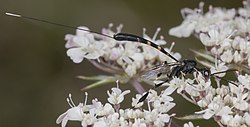Gasteruptiidae
| Gasteruptiidae | |
|---|---|

| |
| Gasteruption jaculator | |
| Scientific classification | |
| Kingdom: | |
| Phylum: | |
| Class: | |
| Order: | |
| Suborder: | |
| Superfamily: | |
| Family: | Gasteruptiidae
|

The Gasteruptiidae are one of the more distinctive families among the apocritan wasps, with surprisingly little variation in appearance for a group that contains around 500 species in two subfamilies (Gasteruptiinae and Hyptiogastrinae) and with 6 genera worldwide.
Genera
This family include the following genera in two subfamilies:[1], [2], [3]
- Gasteruptiinae Ashmead, 1900
- Gasteruption Latreille, 1777
- Plutofoenus Kieffer, 1911
- Spinolafoenus Macedo, 2009
- Trilobitofoenus Macedo, 2009
- Hyptiogastrinae
- Hyptiogaster Kieffer, 1903
- Pseudofoenus Kieffer, 1902
Description
The propleura form an elongated "neck", the petiole attaches very high on the propodeum, and the hind tibiae are swollen and club-like. The females commonly have a long ovipositor (except in the genus Pseudofoenus), and lay eggs in the nests of solitary bees and wasps, where their larvae prey upon the host eggs, larvae and provisions. [4]
The absence of "teeth" on the crown of the head and the somewhat thickened antennae readily separate these wasps from those in the unrelated family Stephanidae, which also contains very slender wasps with long necks.
Distribution
The smaller of the two gasteruptiid subfamilies, Hyptiogastrinae, has a restricted Gondwanan distribution. Hyptiogaster with 10 species is endemic to Australia, whereas of the 80 species of Pseudofoenus, most are found in Australia, with 2 species in New Zealand, 2 species in South America, 5 species in New Guinea and New Britain, and 3 species in the south-west Pacific (New Caledonia, New Guinea, Fiji and Vanuatu).
Gasteruption is worldwide in its distribution, whereas Plutofoenus, Spinolafoenus and Trilobitofoenus are found in South America.
References
- ^ "Hymenoptera Online Database". Archived from the original on 2010-10-21. Retrieved 2017-12-14.
- ^ Jennings, J.T. & Austin, A.D. 2002, Systematics and distribution of world hyptiogastrine wasps (Hymenoptera: Gasteruptiidae). Invertebrate Systematics 16, 735–811.
- ^ Macedo, A.C.C. 2009, Generic classification for the Gasteruptiinae (Hymenoptera: Gasteruptiidae) based on a cladistic analysis, with the description of two new Neotropical genera and the revalidation of Plutofoenus Kieffer. Zootaxa 2075, 1–32.
- ^ Jennings, J.T. & Austin, A.D., 2004. Biology and host relationships of aulacid and gasteruptiid wasps (Hymenoptera: Evanioidea): a review. pp. 187-215. In Rajmohana, K., Sudheer, K., Girish Kumar, P., & Santhosh, S. (Eds.) Perspectives on Biosystematics and Biodiversity. University of Calicut, Kerala, India.
External links
- Gasteruption sp. Diagnostic photos of male and female imagines.
- Gasteruptiidae Tree of Life, extensive article.
- Bugguide.net. Information and images
- Encyclopedia of Life
